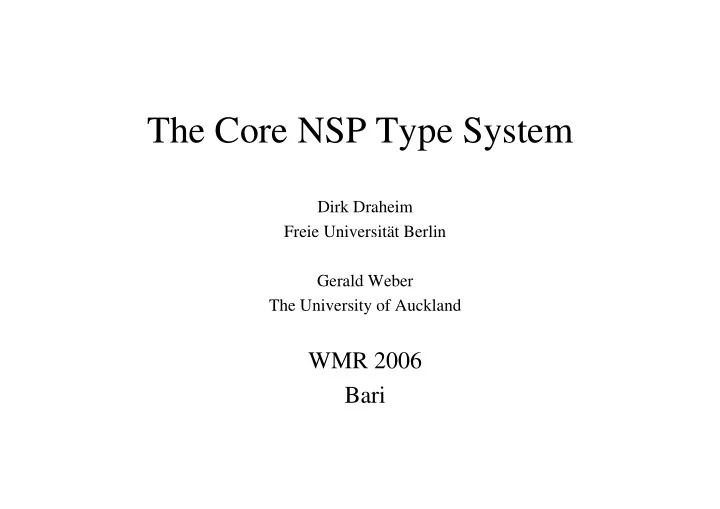

The Core NSP Type System Dirk Draheim Freie Universität Berlin Gerald Weber The University of Auckland WMR 2006 Bari
Server Pages Safety Problems client page description safety: client page forms are editable description safety method calls client page browser server code unit that code unit that processes processes CGI-parameters CGI-parameters and generates and generates page descriptions page descriptions
JSP Counter Example <FORM ACTION="http://www.x.net/NewCustomer.jsp" method="GET"> <% for (int i=0; i<j; i++) {%> <INPUT TYPE="TEXT" NAME="customer" SIZE="20"> <%}%> <INPUT TYPE="TEXT" NAME="age" SIZE="20"> <% if (d == 0) {%> Customer </FORM> <%}%> Submit Age String name; NewCustomer.jsp int age; name = request.getParameter("foobar"); name = request.getParameter("customer"); try { age = new Integer(request.getParameter("age")).intValue(); } catch (IllegalArgumentException _e){}
NSP – Parameterised Server Pages <nsp name="Registration"><head>...</head><body> <form callee="NewCustomer"> <input widget="String" param="customer"></input> <input widget="int" param="age"></input> <submit></submit> </form> </body></nsp> <nsp name="NewCustomer"><head><title>...</title></head> <param name="customer" type="String"/> <param name="age" type="int"/> <java>import myBusinessModel.CustomerBase;</java> <body> <java> CustomerBase.createCustomer(customer,age); </java> <redirect callee="Somewhere"></redirect> </body></nsp>
NSP Features • Parameterised server pages • Support for complex types in forms • Exchanging objects across web interaction • Higher-order server pages • Statically ensured client page description safety • Statically ensured client page type safety • No unresolved links • Active controls • Unifying client-side and server-side calls
NSP Type System • Core NSP • Core NSP Grammar • Core NSP Types • Core NSP Subtyping • Type Operator: signature connection • Core NSP Typing • Theorem: Core NSP type checking is decidable – Core NSP is explicitly typed – Recursive subtyping is decidable
Core NSP Grammar system ::= page | system system page ::= <nsp name="id"> websig-core </nsp> websig-core ::= param websig-core | webcall | include param ::= <param name="id" type="parameter-type"/> webcall ::= <html> head body </html> head ::= <head><title> strings </title></head> strings ::= ε | string strings body ::= <body> dynamic </body> include ::= <include> dynamic </include> string ::= s ∈ String id ::= l ∈ Label parameter-type ::= t ∈ T ∪ P supported-type ::= t ∈ B supported dynamic ::= dynamic dynamic | ε | string | ul | li | table | tr | td | call | form | object | hidden | submit | input | checkbox | select | option | expression | code
Core NSP Types • Programming language types T – basic types B (primitive and supported) – type variables V (including type constants) – array types A , record types R = Label → part T – recursive types Y = { μ X . R | X ∈ V , R ∈ R } • Server page types – page types P = { w → r | w ∈ W , r ∈ C ∪ D } – web signatures W = Label → part (T ∪ P) – complete web page C = {� } complete web page type – document fragment types D = L × W – layout types L = E × F – element types E= { o ,•,TR,TD,LI,OP } neutral doc.t., output t.,etc. – form occurrences F = { ⇓ , ⇑ , c } inside f.t., outside f.t., neutral f.t. – system types S = { ⃟ } well type
Core NSP Typing – Selected Rules I • d ∈ string ⇒ d:(( •, c ), ∅ ) • e:T ⇒ <hidden param=“l“>e</hidden>:(( o , ⇓ ),{l a T}) • T ∈ B supported ⇒ <input type=“T“ param=“l“/>:(( •, ⇓ ),{l a T}) • </submit>:(( •, ⇓ ), ∅ ) • l:w → � , d:((e , ⇓ ), v), v<w ⇒ <form callee=“l“>d</form>:((e , ⇑ ), ∅ ) • l:w → D, as:v, v<w ⇒ <call callee=“l“>as</form>:D • d:(( o or • ,F),w) ⇒ <li>d</li>: (( LI ,F),w) • d:(( LI or o ,F),w) ⇒ <ul>d</ul>: (( • ,F),w) • d 1 :(L 1 ,w 1 ), d 2 :(L 2 ,w 2 ), def ( lub (L 1 ,L 2 )), def (w 1 ⊗ w 2 ) ⇒ d 1 d 2 : ( lub (L 1 ,L 2 ), w 1 ⊗ w 2 )
Core NSP Typing – Selected Rules II • d:D, d ∈ dynamic ⇒ <include>d</include>: ∅→ D • d:(( • or o , ⇑ or c ), ∅ ), t ∈ string, d ∈ dynamic ⇒ <html><head><title>t</title></head><body>d</body></html>: ∅→ � • l:T, c:w → D , l ∉ dom (w) ⇒ <param name="l" type="T" >c: (w ∪ { l a T}) → D • l:P, c:P, c ∈ websig-core ⇒ <nsp name="l"> c </nsp>: ⃟
Core NSP Subtyping – Establishing Rules – • T < array of T • T j ∉ ( B primitive ∪ P ), j ∈ 1..n ⇒ {l i a T i } i ∈ 1..j-1,j+1,..n < {l i a T i } i ∈ 1..n • o < •, o < TR, o < TD, o < LI, o < OP • c < ⇓ , c < ⇑
The Angie Tool Suite Java Click-Dummy Server Pages Prototype End User Developer Angie Generator Load Load Test Angie Angie Report JSPick Revangie Angil Model-Driven Model Recovery Model Recovery Load Test Tool Abstract Platform Java Web Presentation Layer Server Pages
Conclusion • NSP is based on a well-understood system metaphor • NSP ensures CPDS and CPTS at compile time • NSP supports complex types in forms • NSP improves web-based application architecture • NSP seamlessly integrates with form-oriented analysis • NSP has a convenient formal type system
Recommend
More recommend